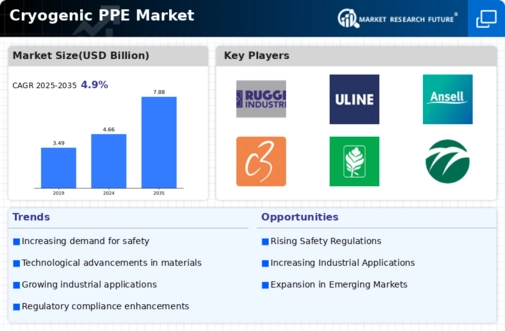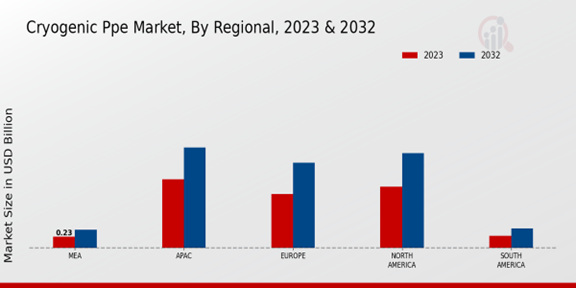Market Trends and Projections
The Global Cryogenic PPE Market Industry is projected to witness substantial growth, with estimates indicating a rise from 4.66 USD Billion in 2024 to 7.88 USD Billion by 2035. This growth trajectory suggests a compound annual growth rate (CAGR) of 4.89% from 2025 to 2035. The market trends reflect an increasing emphasis on safety standards, technological advancements, and the expansion of cryogenic applications, all contributing to the rising demand for specialized PPE. As industries evolve and adapt to new challenges, the need for effective protective equipment will likely remain a priority.
Rising Awareness of Worker Safety
There is a growing awareness regarding the importance of worker safety in environments involving cryogenic materials, which significantly impacts the Global Cryogenic PPE Market Industry. Organizations are increasingly prioritizing the health and safety of their employees, leading to higher investments in protective equipment. Training programs and safety workshops are being implemented to educate workers about the risks associated with cryogenic substances and the importance of using appropriate PPE. This heightened focus on safety not only reduces workplace accidents but also drives the demand for high-quality cryogenic PPE, thereby contributing to market growth.
Expansion of Cryogenic Applications
The Global Cryogenic PPE Market Industry is propelled by the expanding applications of cryogenic technology in various sectors. Industries such as liquefied natural gas (LNG), aerospace, and medical research increasingly utilize cryogenic processes, necessitating specialized PPE to ensure worker safety. The growth of LNG infrastructure, for example, has led to heightened demand for PPE that can withstand extreme temperatures. This trend indicates a broader acceptance of cryogenic technologies, which in turn fuels the need for protective equipment tailored to these environments. The market's expansion is expected to align with the overall growth of these industries.
Increasing Demand for Safety Standards
The Global Cryogenic PPE Market Industry experiences a notable surge in demand driven by stringent safety regulations across various sectors. Industries such as healthcare, aerospace, and energy are increasingly adopting advanced safety protocols to protect workers from cryogenic hazards. The implementation of these regulations not only enhances worker safety but also promotes the use of specialized PPE designed for cryogenic applications. As a result, the market is projected to grow from 4.66 USD Billion in 2024 to 7.88 USD Billion by 2035, reflecting a compound annual growth rate (CAGR) of 4.89% from 2025 to 2035.
Technological Advancements in Materials
Innovations in materials science significantly influence the Global Cryogenic PPE Market Industry. The development of advanced materials that offer superior insulation and durability enhances the effectiveness of cryogenic PPE. For instance, the introduction of lightweight, flexible fabrics that maintain thermal resistance allows for greater mobility and comfort for users. These advancements not only improve the performance of PPE but also encourage wider adoption in industries handling cryogenic substances. As the market evolves, the integration of smart technologies into PPE, such as sensors for monitoring temperature and exposure levels, is likely to further drive growth.
Global Economic Growth and Industrialization
The Global Cryogenic PPE Market Industry is influenced by the ongoing economic growth and industrialization across various regions. As countries invest in infrastructure and industrial projects, the demand for cryogenic technologies and the associated PPE rises. Emerging economies are particularly contributing to this trend, as they adopt advanced technologies in sectors such as energy and manufacturing. This industrial expansion necessitates the use of specialized PPE to protect workers from the hazards associated with cryogenic processes. Consequently, the market is poised for growth as industrial activities increase globally.











